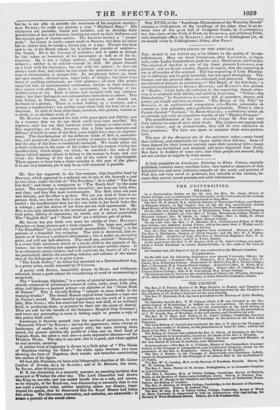Mr. Don has engraved, in the line manner, that beautiful
head by NEWTON, which appeared in a reduced size in one of the Annuals a year
or two since, under the title of "The Forsaken." It is called "The Eng- lish Girl," and forms a companion to "The Dutch Girl" by the same artist. The engraving is exquisitely beautiful; the lines are bold, firm, and clear, and they flow most harmoniously. The flesh tints are pure and delicate, and the effect is perfect. We are not fond of lines to re- present flesh, but here the flesh is the best, and the drapery not so suc- cessful: the handkerchief that the fair one holds in her hand looks like a cabbage ; and the sleeves of her dress are not well represented. Mr. Doo is not only admirable in the technical parts of his art, but in the vital point, fidelity of expression, he excels, and is almost unrivalled. The "English Girl" and "Dutch Girl" are a delicious pair of prints.
Mr. SIIARP has put forth two more fac similes of Jorrx HATTER'S Sketches—a large picture and a little vignette. The large one, entitled "Le Brandillettr" (to avoid the terrible monosyllable "Swing"), is the portrait of a beautiful boy swinging. The style is theatrical, and re- minds us of Cosway's artificial refinements ; but it makes an attractive print, and will not lack admirers. The small one, entitled "Morning," is a sweet little miniature sketch of a lovely child in the attitude of de- votion; but her smiling face appears directed to some earthly object. It is an extremely pretty subject, and will captivate the hearts of all ; but we particularly admire the exceeding delicacy and softness of the execu- tion of the lithograph—it is quite a gem.
" The Little Jockey," an infant boy mounted on a Newfoundland dog, is a pretty print, neatly executed by O'Cosson.
A parrot with flowers, beautifully drawn by GILES, and brilliantly coloured, forms a good subject for transferring to wood or ornamenting a scrap-book. The "Landscape Alphabet," is a series of pictorial letters, most inge- niously composed of picturesque scenes of ruins, rocks, trees, hills, seas, ships, and figures—a pastoral primer—an alphabet of the "Great Book of Nature." This is literally finding "tongues in trees, books in the running brooks." The formal Roman capital letter becomes a type cast in Nature's mould. These tasteful ingenuities are the work of a young lady, Miss JONES; who has exercised her fancy and skill, of no ordinary kind, in producing them, to promote by their sale the cause of charity. They are sold for the benefit of the Seaman's Hospital Ship Grampus ; and every one pretending to taste or feeling ought to possess a copy of -this pretty little work. Landscape is likewise pressed into the service of caricature, in two "Romantic Views" by BAYNES ; having the appearance, when viewed as landscapes, of castles in rocky scenery only, but upon turning them round, the picture exhibits the profile of a face, one an ideal head of Captain Rock, the other a real one—a most expressive likeness—of Sir Watkins Wynn. The idea is not new, but it is good, and when applied to real persons, amusing.
A similar kind of ingenuity is shown in a little print of "The Shade of Napoleon visiting his Tomb ;" the white space between two trees showing the form of Napoleon, their trunks and branches constituting the outline of his figure.
Of bonk fide Portraits, we have only lithographic sketches of Mr. Lister (author of Granby, &c.), by SLATER; and of G. Bennett, the actor, by SHARP, after STROERLINO. H. B. has chronicled, in a masterly manner, an amusing incident that :occurred at Windsor the other day. The Lord Chancellor had drawn the King on one side, and was seated beside him on a sofa, and secure, as he thought, of the Royal ear, was discoursing so earnestly that it was not until a singular noise, neither implying assent nor dissent, inter- rupted his speech, that he discovered that his Royal Master had fallen fast asleep. The likenesses, expression, and attitudes, are admirable : it mews a portrait of the actual scene. Part XVIII.of the "Landscape Illustrations of the Waverley Novels" contains a vivid picture of the revellings of the olden time, in an in- terior view of the great hall of Craigevar Castle, by Carrsumor.x ; two fine views of the Frith of Forth, by STANFIELD, and of Solway Frith, with moonlight effect, by BARRETT ; and a view of Goldingham (or, as we should write it, Coldinghame) Abbey, after PROUT.


























 Previous page
Previous page